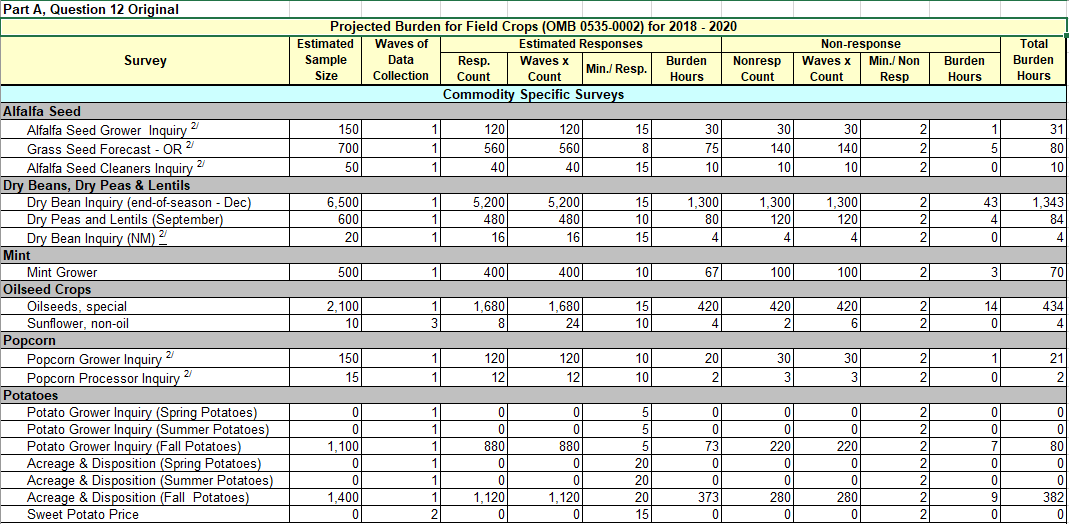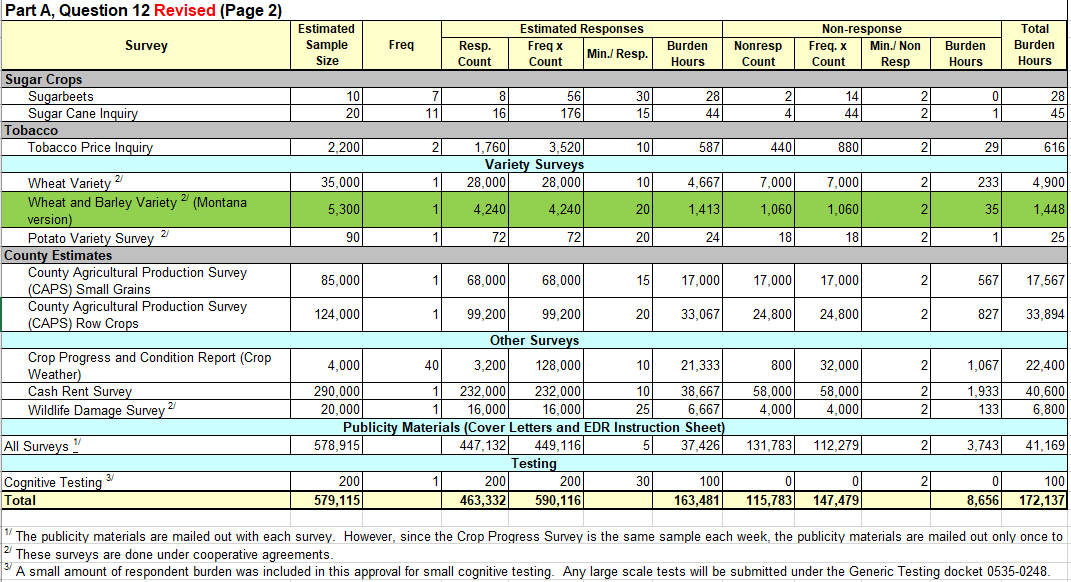Supplemental Supporting Statement A for Montana Wheat & Barley Variety Survey Substantive Change Request
0002-fieldcrops-2021-SSA - Substantive Change - Montana Wheat Barley Variety - 03-26-2021.docx
Field Crops Production - Non-Substantive Change Request for Hawaii Seed Crops
Supplemental Supporting Statement A for Montana Wheat & Barley Variety Survey Substantive Change Request
OMB: 0535-0002
SUPPLEMENTAL SUPPORTING STATEMENT Part A
FIELD CROPS PRODUCTION
Substantive Change
OMB No. 0535-0002
This substantive change is being submitted as a supplemental supporting statement to the Field Crops Production docket. This document identifies changes made to the Wheat and Barley Variety Survey that will be conducted in Montana in 2021.
A. JUSTIFICATION
1. Circumstances making collection of information necessary.
NASS is requesting a substantive change to the wheat and barley variety survey for the 2021. NASS entered into an agreement with the Montana Wheat and Barley Commission to conduct the Wheat and Barley Variety Survey for crop year 2021. The survey will ask questions on
Acres of durum wheat, other spring wheat, winter wheat, and barley by variety, as well as
The respondent’s primary factor for choosing a variety to plant,
The primary agronomic trait, after yield and protein, the respondent uses to determine a variety to plant,
The respondent’s overall impression of the profitability and stability of the operation.
The acreage questions are already included in the approved survey, but the latter three questions are new to help wheat experts in Montana understand what growers in the State expect when choosing which wheat and barley varieties to plant in a given year.
2. How, by whom, and for what purpose information is to be used.
There are no changes to the list of potential people who use the data collected by the Wheat and Barley Variety Surveys. The added questions on factors and traits will help wheat experts in Montana understand what growers in the State expect when choosing which wheat and barley varieties to plant in a given year.
3. Use of improved information technology.
The wheat and barley variety survey being impacted by this substantive change will be converted over to electronic data reporting (EDR). This is the first year EDR will be used for this survey.
4. Efforts to identify duplication.
There are no changes from the original approval related to duplication reduction.
5. Methods to minimize burden of small businesses.
Information requested on surveys included in this docket can be provided with a minimum of difficulty by respondents, generally without having to consult their record books.
For the Montana Wheat & Barley Variety Survey, approximately 46 percent of the estimated sample size of 5,300 will be small operations. The over all information collection has a combined sample size of 579,115 with about 84 percent of the sample being small operations.
6. Consequence if information collection were less frequent.
There are no changes to the frequency of these surveys that was originally approved.
Special circumstances.
No special circumstances are associated with this information collection.
Federal register notice and consultation with outside persons.
Input for the questions other than variety were provided by the following:
Cassidy Marn: [email protected] 406-788-7694
Executive Vice President of Montana Wheat & Barley Commission,
Charlie Bumgarner [email protected] 406-788-1216, and
Mike O'Hara [email protected] 406-899-6903
Payments or gifts to respondents.
No payments or gifts will be given to respondents.
Confidentiality provided to respondents.
Questionnaires include a statement that individual reports are confidential. 44 U.S. Code Chapter 35; and Public Law 115-435, Title III (CIPSEA) provide for confidentiality of reported information. All employees of NASS and all enumerators hired and supervised under a cooperative agreement with the National Association of State Departments of Agriculture (NASDA) must read the regulations and sign a statement of compliance.
Additionally, NASS employees and NASS contractors comply with the OMB implementation guidance document, “Implementation Guidance for Title V of the E-Government Act, Confidential Information Protection and Statistical Efficiency Act of 2002 (CIPSEA).” CIPSEA supports NASS’s pledge of confidentiality to all respondents and facilitates the agency’s efforts to reduce burden by supporting statistical activities of collaborative agencies through designation of NASS agents, subject to the limitations and penalties described in CIPSEA.
Questions of a sensitive nature.
No questions of sensitive nature will be asked.
12. Provide estimates of the hour burden of the collection of information. The statement should indicate the number of respondents, frequency of response, annual hour burden, and an explanation of how the burden was estimated.
The following table contains the adjusted, estimated annual burden hours for this group of surveys. Cost to the public for completing the questionnaire is assumed to be comparable to the hourly rate of those requesting the data. Average annual reporting time of 172,137 hours is multiplied by $37.47 per hour for a total annual cost to the public of $ 6,449,973.39.
NASS uses the Bureau of Labor Statistics’ Occupational Employment Statistics (most recently published on March 31, 2020 for the previous May) to estimate an hourly wage for the burden cost. The May 2019 mean wage for bookkeepers was $20.65. The mean wage for farm managers was $38.63. The mean wage for farm supervisors was $25.25. The mean wage of the three is $28.18. To calculate the fully loaded wage rate (includes allowances for Social Security, insurance, etc.) NASS will add 33% for a total of $37.47 per hour.
Average completion time per questionnaire is based on time required for other surveys of similar length. Calculation of burden hours is shown in the table below. Estimated response counts are based on an 80% target response rate and minutes per response shown are the average times for all questionnaires used for the commodity.


 13. Provide
an estimate of the total annual cost burden to respondents or record
keepers resulting from the collection of information.
13. Provide
an estimate of the total annual cost burden to respondents or record
keepers resulting from the collection of information.
There is no cost burden to respondents.
14. Annualized costs to federal government.
The cost to reinstate the Montana Wheat and Barley Variety Survey is approximately $45,000, most of which is staff costs. This includes the fully loaded wage rate (includes allowances for Social Security, insurance, etc.). The costs will be reimbursed by the Montana Wheat and Barley Commission. There will be no cost to the Federal government.
15. Reasons for changes in burden.
The revised total burden of 172,137 hours is up 1,837 hours from the current inventory of 170,300 hours. The increase is due to reinstating the Montana Wheat and Barley Variety Survey.
16. Tabulation, analysis, and publication plans.
The only planned change to publications is an additional publication with the results of the Montana Wheat and Barley Variety Survey, planned for publication in late summer, 2021.
17. Request for approval of non-display of expiration date.
There is no request for approval of non-display of the expiration date.
18. Exceptions to certification statement.
There are no exceptions to the certification statement.
March 2021
| File Type | application/vnd.openxmlformats-officedocument.wordprocessingml.document |
| Author | hancda |
| File Modified | 0000-00-00 |
| File Created | 2022-01-25 |
© 2026 OMB.report | Privacy Policy